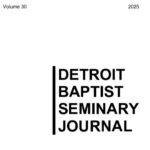The Descent of Christ (Part 2)
Read Part 1 of this series here.
Christ descended in the incarnation on the first Christmas. He came to earth as a man forever binding himself to humanity. This much is certain.
But did Christ descend into Sheol (ᾅδης/hades/inferos/inferna) after his death? I argue here that church tradition affirms the descent of Christ into Sheol. Of course, this is only valid in so far as it reflects the teaching of Scripture. Is the descent of Christ affirmed in Scripture, and where is it taught?
Let me begin with the observation that several passages manifest a gospel tradition behind the text. Multiple factors make this plain. (1) An allusion to tradition or a deposit received, (2) a clear sequence of gospel events, (3) and shared, programmatic terms together reveal a gospel tradition informing the theology of the NT. Analyzed from a number of perspectives, the descent of Christ fits well in this gospel tradition.
The most sensible place to begin our investigation is 1 Corinthians 15. At this juncture in the letter, Paul moves to remind the Corinthians of a primarily important tradition that they received via apostolic preaching. The use of the verb “receive” (παρέλαβον, 1 Cor 15:3) alludes to the deposit of apostolic truth. The gospel sequence unfolds in verses 3–11. Christ died (ἀπέθανεν), was buried (ἐτάφη), rose on the third day ( ἐγήγερται τῇ ἡμέρᾳ τῇ τρίτῃ), and appeared (ὤφθη).
Next, let’s analyze 1 Timothy 3. In this letter to his ministry protege, Paul reminds Timothy of the essence of the faith, which the church is responsible to buttress. In this context, he lays down a formulaic expression of the gospel. The verb, we confess, frames what follows in doctrinal terms (ὁμολογουμένως, “Great indeed, we confess, is the mystery of godliness,” 1 Tim 3:16). Verse 16 functions as a form of sound words (cf. 1 Tim 6:3) rehashing the gospel sequence. Christ was manifest in the flesh (i.e., the incarnation), vindicated by the Spirit (i.e., the resurrection), seen by angels (potentially referencing the imprisoned spirits of 1 Peter 3:19), believed on in the world (likely speaking of his post-resurrection appearances), and taken up into glory (i.e., the ascension).
Now, we move from 1 Timothy to Ephesians 4. At the beginning of Ephesians 4, Paul refracts the Shema Yishrael through Jesus and the truth once for all delivered to the saints. “There is one body and one Spirit—just as you were called to the one hope that belongs to your call— one Lord, one faith, one baptism, one God and Father of all, who is over all and through all and in all” (Eph 4:4–6). From this all-important doctrinal confession, he proceeds to reiterate the gospel sequence. This time, he works backward, beginning with the ascension (“When he ascended on high,” a citation of Ps 68:18 picked up by Paul in Eph 4:8). From the triumph of the ascension, Paul infers the descent of Christ into the lower parts of the earth (κατέβη εἰς τὰ κατώτερα μέρη τῆς γῆς). Taken together, the partitive genitive[1] (“parts of the earth”) and the comparative adjective (“lower”) would seem to rule out a reference to the incarnation. Accounting for the confessional context and the gospel sequence, perhaps the most straightforward referent is the descent of Christ into Sheol from whence “he led captivity captive” (Eph 4:8). Paul concludes the gospel sequence by returning to the victory of the ascension. “He who descended is the one who also ascended far above all the heavens, that he might fill all things” (Eph 4:10). The symphony of gospel events crescendos in the Christus Victor theme. Since Christ is now seated in the place of power, he is able to fill his body with divine gifts.
We have one more stop on our brief survey of formulaic expressions of the gospel, 1 Peter 3. In this context, Peter stresses Christ’s example of suffering, which happened according to the will of God and powerfully achieved God’s purpose. Peter begins the gospel sequence with a reference to Christ’s suffering (ἔπαθεν, “For Christ also suffered once for sins,” 1 Peter 3:18). Next comes an ascription of Christ’s death (θανατωθεὶς) followed by an affirmation of his resurrection through the instrumentality of the Spirit (ζῳοποιηθεὶς δὲ πνεύματι). According to my interpretation, 1 Peter 3:19 describes the descent of Christ in the power of the Spirit to proclaim his victory to the imprisoned spirits.[2] I take 1 Peter 3:20 as a reference to the Genesis 6 event. These verses emphasize the Christus Victor component of the gospel. Christ’s proclamation of victory to the imprisoned spirits climaxes in his ascension to the right hand of the Father, enthroned over all of the dark powers (“who has gone into heaven and is at the right hand of God, with angels, authorities, and powers having been subjected to him,” 1 Peter 3:22).
Returning to the overall point, in my understanding, these passages manifest a gospel tradition behind the text. These letters are circumstantial documents that draw from a shared truth deposit. These documents reflect the form of sound words (cf. 2 Tim 1:13), the kerygma of apostolic preaching, only accessible to us in the inspired texts themselves. Correlating these gospel forms, in my view, supports the reality of the descent of Christ into Sheol. The descent of Christ suits the gospel sequence.
We must hasten to a conclusion, so I will briefly mention correlating arguments in support of the descent of Christ. The most obvious is Peter’s citation of Psalm 16 in his Pentecost sermon (Acts 2:24–33). Drawing from David’s prophesy in Psalm 16, he locates Jesus in Sheol (ᾅδην) on Holy Saturday. He wasn’t abandoned to Sheol, nor did his flesh see corruption. Rather, God raised and exalted him. Likewise, Christ’s descent into Sheol makes the most sense of his statement to Mary Magdalene in the garden after the resurrection.[3] “Do not cling to me, for I have not yet ascended to the Father; but go to my brothers and say to them, ‘I am ascending to my Father and your Father, to my God and your God’” (Jn 20:17). The gospel sequence prompts the question, “Where was Jesus on Holy Saturday?” Beyond doubt, his body was in the tomb of Joseph of Arimathea. It seems most sensible to locate the immaterial part of his person in Sheol, not only because Acts 2 references him there but also because he had not yet ascended to the right hand of the Father. It would seem that if the immaterial part of Jesus entered the locus of God’s presence in heaven after Good Friday, then the ascension would lose its significance. Please allow me one final strand of proof. The descent of Christ makes the most sense of Christ’s possession of the keys of death and Hades (i.e., Sheol, ᾅδην, cf. Rev 1:18). The gates of Hades (ᾅδου) shall no longer prevail over the church (Matt 16:18) in the sense that Sheol is no longer the holding place of the righteous dead. So many of these assertions demand expanded argumentation and substantiation, but this is, after all, a blog post, not a peer-reviewed article.
Celebrate Christmas this year knowing that Christ not only condescended to us in the incarnation but also descended into Sheol, proclaiming his eternal triumph over all of the dark powers. O come let us adore him.
[1] I acknowledge that some exegetes take this as a genitive of apposition.
[2] It’s difficult to say whether the proclamation of Christ’s victory occurred post-crucifixion but pre-resurrection, or if it occurred post-crucifixion and post-resurrection but pre-ascension. I suppose both schemes could be accomplished through the instrumentality of the Spirit, and both generally fit the timeline of gospel events.
[3] I owe this observation to Michael Bird in What Christians Ought to Believe (Grand Rapids: Zondervan, 2016).



